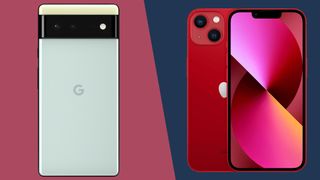
Google has finally released the Pixel 6, adding an all new affordable flagship contender to the market.
Naturally, this means that it's running slap bang into Apple's iPhone 13, which hasn't been long on the market itself. The two phones offer classy specs at less-than-pro prices.
These are two phones that present showcases for two giant mobile operating systems in Android 12 and iOS 15. This is a battle of hardware AND software.
We've spent some solid time with both phones at this point, and have offered our opinions on them individually. Now let's take a look at how they fare against one another.
Google Pixel 6 vs iPhone 13 price and availability
The Pixel 6 hit shops on October 28, with prices starting from £599 for the 128GB model. Alternatively, you can a 256GB model that will set you back AU$1,129, with pricing in other regions still to be confirmed at the time of writing.
The iPhone 13 arrived a month earlier than the Pixel 6 on September 24, 2021. Pricing commences from $799 / £799 / AU$1,349 for 128GB of storage. Paying $899 / £879 / AU$1,519 will get you 256GB, while $1099 / £1079 / AU$1,869 gets you 512GB.
As you can see, the Pixel 6 is significantly cheaper than the iPhone 13, but Apple's phone offers more range.
Get daily insight, inspiration and deals in your inbox
Get the hottest deals available in your inbox plus news, reviews, opinion, analysis and more from the TechRadar team.
Google Pixel 6 vs iPhone 13: Design
The Google Pixel 6 is significantly larger than the iPhone 13, at 158.6 x 74.8 x 8.9mm. The iPhone 13's 146.7 x 71.5 x 7.65mm dimensions feels quite tiddly by comparison.
Apple's phone is also way lighter than Google's, to the tune of 174g versus the 207g Pixel 6.
There's no getting around it – the Pixel 6 is a rather hefty device, especially given its 'non-Pro' status. That camera module makes it feel rather top-heavy, too.
There's no denying which phone sports the fresher design of the two, however. Google's bold new design feels genuinely original, with a two-tone finish (in Stormy Black, Sorta Seafoam, and Kinda Coral) and a bravely prominent camera module that runs the entire width of the device.
That 'camera bar', as Google calls it, might look interesting, but we're a little worried that it might be a little more vulnerable to damage. We'll have to wait and see on that one.


Still, at least its symmetrical shape means that the Pixel 6 sits straight on a table. The iPhone 13's larger camera module, positioned off to the side, makes it feel slightly unsteady when sat on a table.
More generally, the iPhone 13 design is attractive, but doesn't move things forward much from last year's iPhone 12. Just about the only consequential change is a display notch that's 20% smaller, but of course the Pixel 6 has a central hole punch notch that's smaller still.
The payoff for this is that the iPhone 13 gets Face ID, while the Pixel 6 uses a more traditional in-display fingerprint sensor for biometric authentication.
Both phones have an IP68 dust and water resistance rating. Around front the iPhone 13 gets a nano-crystalline Ceramic Shield, while the Pixel 6 has an off-the-shelf Gorilla Glass Victus display cover.
You get a strong stereo sound from both phones, too. We noted the impressive balance of the Pixel 6's speakers in our review, but both phones acquit themselves well.
Google Pixel 6 vs iPhone 13: display
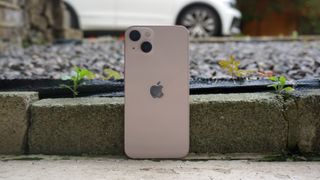
The Google Pixel 6 display is a 6.4-inch OLED with a 2400 x 1080 (FHD+) resolution. That makes it larger but less sharp than the iPhone 13's 6.1-inch Super Retina XDR OLED screen with its 2532 x 1170 resolution.
Not that you'll particularly notice the relative pixel shortfall of the Pixel 6. We tested it alongside the Pixel 6 Pro, with its even sharper QHD resolution, and could only really discern a difference when we got close to the screen.
Where the Pixel 6 beats its Apple rival is when it comes to fluidity. Google's phone has a 90Hz refresh rate, which is 50% speedier than the 60Hz iPhone 13.
It's a shame Apple didn't advance this particular area of screen technology, especially given that the iPhone 13 Pro goes up to a silky 120Hz.
Our reviewer observed that the Pixel 6 screen tended towards a more vibrant mix of colors than Apple's iPhones, with greater contrast. It remains to be seen how bright the Pixel 6 screen gets. The iPhone 13 hits 800 nits in typical conditions and 1200 nits when viewing HDR content, which is pretty strong.
Google Pixel 6 vs iPhone 13: cameras
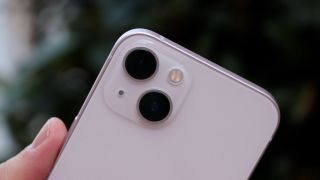
Both of these phones pack much improved dual camera systems, but they're far from identical.
Google has taken a big step forward with the Pixel 6's camera set-up after several years of treading water. It's led by a huge 1/1.31-inch 50MP wide sensor with an f/1.85 aperture. This produces 1.2μm pixels, though it uses a pixel-binning technique to effectively capture larger pixels for its 12.5MP images.
We observed that the Pixel 6 takes better pictures than last year's iPhone 12 Pro, with which the iPhone 13 shares a fair amount in common. But then, Apple has also taken a major step forward with its own camera offering. The iPhone 13 packs a 12MP wide sensor that can generate large 1.7µm pixels, accompanied by a wide open f/1.6 aperture.
Both phones pack 12MP ultra-wide sensors. In the Pixel 6's case that's accompanied by an f/2.2 aperture, while the iPhone 13 goes with an f/2.4 aperture. You'll have to go with their Pro brothers if you want a dedicated telephoto lens, meanwhile.
The iPhone 13's sensor shift stabilization system may just give it the edge when it comes to super steady night time shots, but we'll know more on that once we've spent some more time with the Pixel 6.
Google and Apple are arguably the two leaders when it comes to image processing tricks. Their software does even more of the heavy lifting than their hardware, in fact.
The Pixel 6's new Motion mode is a bit of a mixed bag, with Action Pan and Long Exposure capturing still subjects with motion around it and blurring light trails, respectively.
Apple gives you Photographic Styles, which lets you change the fundamental tone of a shot without resorting to gaudy, cheap filters.
This year Google is gunning for Apple's smartphone video crown. Both phones can record 4K video at 60fps, but Google has brought its AI smarts over from stills to moving footage, courtesy of the Tensor chip.
Live HDR+ promises to enhance colors and tones, while Speech Enhancement can isolate voices amongst lots of background noise.
Apple hasn't rested on its laurels when it comes to video. 'Cinematic mode' enables you to change the focus in a scene, even after the footage has been shot. It will also automatically change the focus depending on the gaze of the subject.
Google Pixel 6 vs iPhone 13: specs and performance
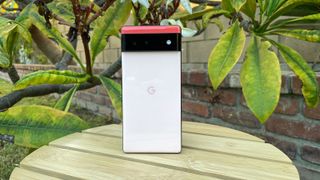
Google claims that the Tensor is competitive with Android rivals such as Qualcomm's Snapdragon 888 for raw performance. That may be a slight stretch based on what we're seeing. The iPhone 13's A15 Bionic certainly hands out a hiding using traditional metrics.
Apple's chip is blisteringly fast, with Geekbench 5 multi-core scores hitting an average multi-core score of 4688 to the Pixel 6's 2837.
Of course, a chip's worth isn't all about raw CPU and GPU power. Google has been at great pains to highlight the Tensor chip's machine learning smarts, which apparently pays off with things like those aforementioned camera tricks.
It's also simply a very good runner in all the practical tasks that matter. Apps, multitasking, web browsing, and gaming all run smoothly on the Pixel 6.
The Pixel 6 comes with 8GB of RAM to the iPhone 13's 4GB, but we should repeat the caveat that Android and iOS use their resources in completely different ways.
In terms of storage, the Pixel 6 comes in 128GB and 256GB variants, though the larger capacity isn't on offer in all territories. The iPhone 13 gives you 128GB, 256GB, and 512GB options wherever you are in the world.
Google Pixel 6 vs iPhone 13: software
For all this talk of hardware differences, the key difference between the Pixel 6 and the iPhone 13 could come down to software.
These phones are the champions of the two biggest (and only) mobile operating systems around. The Pixel 6 runs Android 12, while the iPhone 13 runs iOS 15.
Google's Android 12 is certainly the most novel of the two, with a bright new Material You UI adding theming ingenuity and a fresh lick of paint to some familiar underpinnings.
That's not to say that iOS 15 is dull or bad, just that it's more of an iterative update over what has gone before. The next big iOS overhaul is a little further down the line, it seems.
Both operating systems have borrowed elements from one another over the years, to the point where there isn't as much between them as die hard fans would like to admit. Which is to say: they're both great.
Still, if you're heavily invested in either Google's or Apple's ecosystem, with stacks of app or game purchases on one side, that's the device that's likely to be better suited to you.
Google Pixel 6 vs iPhone 13: battery
The Google Pixel 6 packs a 4612mAh battery, while the iPhone 13 gets you a 3240mAh cell.
Not that this tells you anything about which phone has the best stamina. As we've mentioned, Android and iOS handle resources quite differently.
Google is promising 48 hours of battery life, albeit through Android 12's Extreme Battery Saver mode. In more general terms, we found that the Pixel 6 comfortably makes it through a full day of use.
Apple for its part claims a 2.5 hour increase on battery life compared to the iPhone 12. In our experience, the iPhone 13 tended to leave us with a solid 20% left in the tank after a full day of usage.
There's a palpable lack of excitement over the charging provisions on offer from both manufacturers, however. Neither phone bundles in a charger, for one thing, and the charging speeds are far from inspiring.
The Pixel 6 supports 30W wired charging, which is better than the iPhone 13's 20W. But it's still hardly the 65W or 120W standard supported by the likes of Oppo and Xiaomi.
On the wireless charging front, the Pixel 6 support up to 21W, while the iPhone 13 supports up to 15W. But in the Pixel 6's case, that's only with Google's Pixel Stand. It otherwise only extends to 12W.
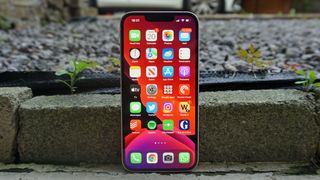
Takeaway
These are two impressively complete phones with less-than-peak price tags, excellent dual camera systems, classy designs, and impressive custom processing power.
There are differences, though. The iPhone 13 is the more conventionally powerful of the two, and it also enjoys superior battery life.
The Pixel 6, by contrast, enjoys a cheaper price tag, a more fluid display, and a slightly fresher design.
If we were to give the nod to one of these phones, we'd have to go with Apple's iPhone 13. It's just a little more rounded as a package. But both of these phones are excellent mainstream champions of their respective smartphone platforms, and if you're particularly wedded to either iOS or Android, you should probably select your phone accordingly.
- Take a look at all the other best smartphones
- What we expect from the Samsung Galaxy S22







